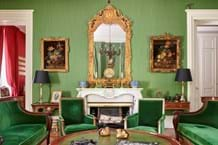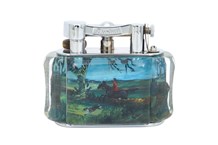The best of the clocks and the top selling piece of furniture both went abroad, the latter to an American dealer.
A number of longcases from the collection of a late Cotswolds resident were the major single draw of the day. Best of the collection and indeed the entire sale was a
Dutch mid-18th century longcase clock made by Haarlem maker J Coelombie.
The clock had a brass and silvered dial with rolling moon movements, date aperture and a secondary seconds dial. The 8ft 10in (2.69m) high clock had lots of interesting decoration. Painted figures displaying the days of the week adorned the clock’s face and the walnut case was surmounted with trumpeter figures and the door with a figure of Father Time.
The longcase was in good condition bar a few cracks and splits to the case and was expected to take between £8000-12000. After competitive trade bidding, the clock returned close to its homeland when it was taken by Belgian dealer De Grande at £8200.
Another 18th century longcase from the same collection got away just below the bottom estimate of £8000.
This London clock by Arlander Dobson had an arched brass dial with a silvered chapter ring, date aperture and a subsidiary seconds dial.
The 8ft 3in (2.51m) high clock was in “reasonable” condition and in a burr walnut case with a leafage fret-carved frieze with fluted columns and gilt corinthian capitals to the hood. It was taken up by a Kidderminster private buyer at £7300.
A Welsh private took home another 18th century longcase from the collection. London-made and in a walnut case with a fret-carved frieze and turned pillars, the 7ft 10in (2.38m) high clock took £5900.
The rest of the top prices were in the furniture.
From a deceased estate in Shropshire came a set of eight Chippendale-style mahogany dining chairs. Five phone lines were booked on this set, which had ribbon carved and pierced splats, woolwork upholstered drop-in seats and carved cabriole legs with claw and ball feet.
The set, which consisted of two carvers and six singles, was in very good condition and expected to bring £2000-3000. After strong bidding from a mixture of dealers and one private buyer, an American dealer bidding in the room was the successful bidder at £8000, proving that the Americans were still determined to buy.
Being so close to the Welsh border, these rooms have a reputation for selling good quality Welsh vernacular oak furniture. The specialised oak trade took an 18th century oak cupboard. fitted with two doors both with fielded panels enclosing shelves and three spare drawers, and three graduated drawers beneath. The 5ft 9in (1.75m) cupboard exceeded expectations to bring £2300.
A 7ft 4in (2.23m) high oak dresser base from a Shropshire private in good condition and of a good colour was a trade buy at £3700. Two Victorian mahogany extending dining tables also found favour. The better seller of the two was an early Victorian oval example. The table measured 4ft by 9ft 4in (1.21 x 2.84m) when it was fully extended with its three extra leaves and was a trade buy at £3600. A different dealer took the other extending piece.
At 4ft by 7ft 10in (1.21 x 2.38m) this table was slightly smaller than the others but had an attractive grain which one onlooker described as “almost like a plum pudding mahogany” and was of very good quality, needing only a small amount of work. It got away over estimate at £3300.
A “very pleasant surprise” was how auctioneer Geoffrey Croft described the unexpected success of a Persian carpet expected to take £60-80. The carpet, which was rather worn, had yellow and brown stylised floral decoration on a deep red ground.
The successful dealer, bidding on the telephone, had only seen a digital image of the carpet but clearly something attracted him to chase it to £3000.
In the ceramics pairs were the order of the day. A pair of 31/2in (9cm) high Worcester majolica Conch shells on round sea green floor bases, had a few cracks but still took a mid-estimate £880.
Similarly, the considerable damage to a pair of Welsh consigned composition pug dogs with brown collars and glass eyes was less important than their rarity as far as a Welsh dealer was concerned. He took the pair, which were expected to bring £150-200, at £780.
An £8000 bid is doubly welcome – coming from an American
THE trade’s fears that the events of September 11 would usher in the long expected recession with a collapse in international bidding were allayed here in Herefordshire at Brightwells on 12-13 September.




